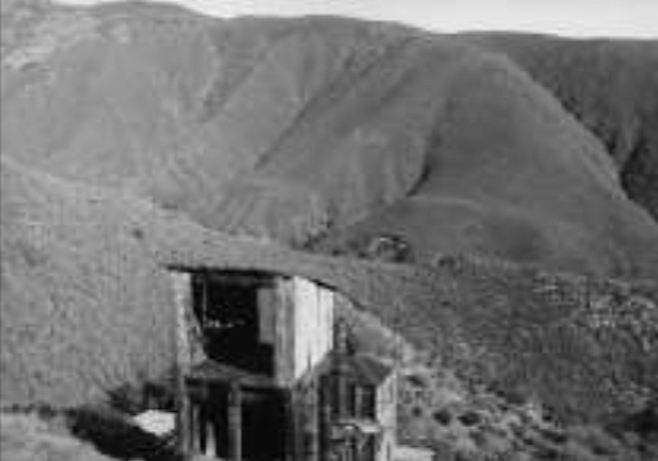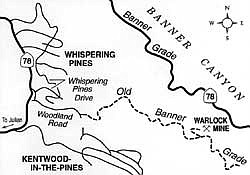 Facebook
Facebook
 X
X
 Instagram
Instagram
 TikTok
TikTok
 Youtube
Youtube

Honeycombed hillsides and bits and pieces of rusted equipment -- that is the legacy left behind by Julian's gold-mining heyday over a century ago. Although a few mines continue to be worked sporadically even today, most have long been abandoned. For a look at the Warlock Mine -- one of the first mines to be discovered (1870) and one of the last to be extensively worked -- try this short hike down the Old Banner Grade.

To get to the starting point for the walk, drive one mile east from Julian on Highway 78, and turn right at Whispering Pines Road. Immediately after, make a sharp right, then a left to connect with Woodland Road. After 0.5 mile on Woodland Road, the pavement ends and an old dirt road continues on a sharply curving descent. Park your car where you can find space to do so.
On foot (or by mountain bike), follow the dirt road as it descends generally eastward. The old road, now essentially a trail, was built as a wagon road around the turn of the 19th century. Below you is its modern equivalent -- Banner Grade, or Highway 78. The highway appears only slightly less twisting than the road you are on but offers a more gradual, if longer, descent to the town of Banner. Below the level of Highway 78, near the very bottom of the canyon, there once existed even earlier routes of travel between Julian and Banner. The earliest was a "skid road" so steep that a driver descending on it would have to drag an uprooted tree behind his wagon to provide enough braking power.
The linear shape of Banner Canyon is due to repeated ruptures along the Elsinore Fault. This splinter fault of the San Andreas is the most extensive fault system in San Diego County and is believed capable of causing a major earthquake. Look across the canyon to see the fault's surface trace, which cuts low across the canyon's north slope, and also notice how some of the ravines on the slope exhibit a dogleg, or offset, pattern due to horizontal movements.
Old mine shafts pierce the earth on the steep slopes above and below you. Much of the surrounding area was swept by the flames during the Pines Fire of 2002, so some of these mines are easier to spot than before when thick chaparral grew over them. It is patently unsafe to enter any mine tunnel, especially the ones in this area, which have not been maintained for many decades or a century or more.
After about one mile of travel, the Warlock Mine, first worked in 1870, comes into view below and to the left. The mine suspended operations in 1957, and you can still see remnants of its processing mill. Tread carefully among the ruins.


Honeycombed hillsides and bits and pieces of rusted equipment -- that is the legacy left behind by Julian's gold-mining heyday over a century ago. Although a few mines continue to be worked sporadically even today, most have long been abandoned. For a look at the Warlock Mine -- one of the first mines to be discovered (1870) and one of the last to be extensively worked -- try this short hike down the Old Banner Grade.

To get to the starting point for the walk, drive one mile east from Julian on Highway 78, and turn right at Whispering Pines Road. Immediately after, make a sharp right, then a left to connect with Woodland Road. After 0.5 mile on Woodland Road, the pavement ends and an old dirt road continues on a sharply curving descent. Park your car where you can find space to do so.
On foot (or by mountain bike), follow the dirt road as it descends generally eastward. The old road, now essentially a trail, was built as a wagon road around the turn of the 19th century. Below you is its modern equivalent -- Banner Grade, or Highway 78. The highway appears only slightly less twisting than the road you are on but offers a more gradual, if longer, descent to the town of Banner. Below the level of Highway 78, near the very bottom of the canyon, there once existed even earlier routes of travel between Julian and Banner. The earliest was a "skid road" so steep that a driver descending on it would have to drag an uprooted tree behind his wagon to provide enough braking power.
The linear shape of Banner Canyon is due to repeated ruptures along the Elsinore Fault. This splinter fault of the San Andreas is the most extensive fault system in San Diego County and is believed capable of causing a major earthquake. Look across the canyon to see the fault's surface trace, which cuts low across the canyon's north slope, and also notice how some of the ravines on the slope exhibit a dogleg, or offset, pattern due to horizontal movements.
Old mine shafts pierce the earth on the steep slopes above and below you. Much of the surrounding area was swept by the flames during the Pines Fire of 2002, so some of these mines are easier to spot than before when thick chaparral grew over them. It is patently unsafe to enter any mine tunnel, especially the ones in this area, which have not been maintained for many decades or a century or more.
After about one mile of travel, the Warlock Mine, first worked in 1870, comes into view below and to the left. The mine suspended operations in 1957, and you can still see remnants of its processing mill. Tread carefully among the ruins.
Comments